Financial Statement Analysis and Management Accounting Planning
VerifiedAdded on 2024/06/11
|20
|4030
|397
Report
AI Summary
This report provides a comprehensive analysis of management accounting, covering its role, integration within organizations, and benefits. It delves into financial statement analysis of Balfour Beatty and Kier Group, comparing their profitability, liquidity, gearing, market ratios, and efficiency. The report also prepares profit and loss statements using both absorption and marginal costing techniques, illustrated with the example of Areal Ltd. Furthermore, it compares and contrasts three planning tools used in management accounting, evaluating their effectiveness. This document, contributed by a student, is available on Desklib, a platform offering AI-based study tools and a wealth of academic resources for students.
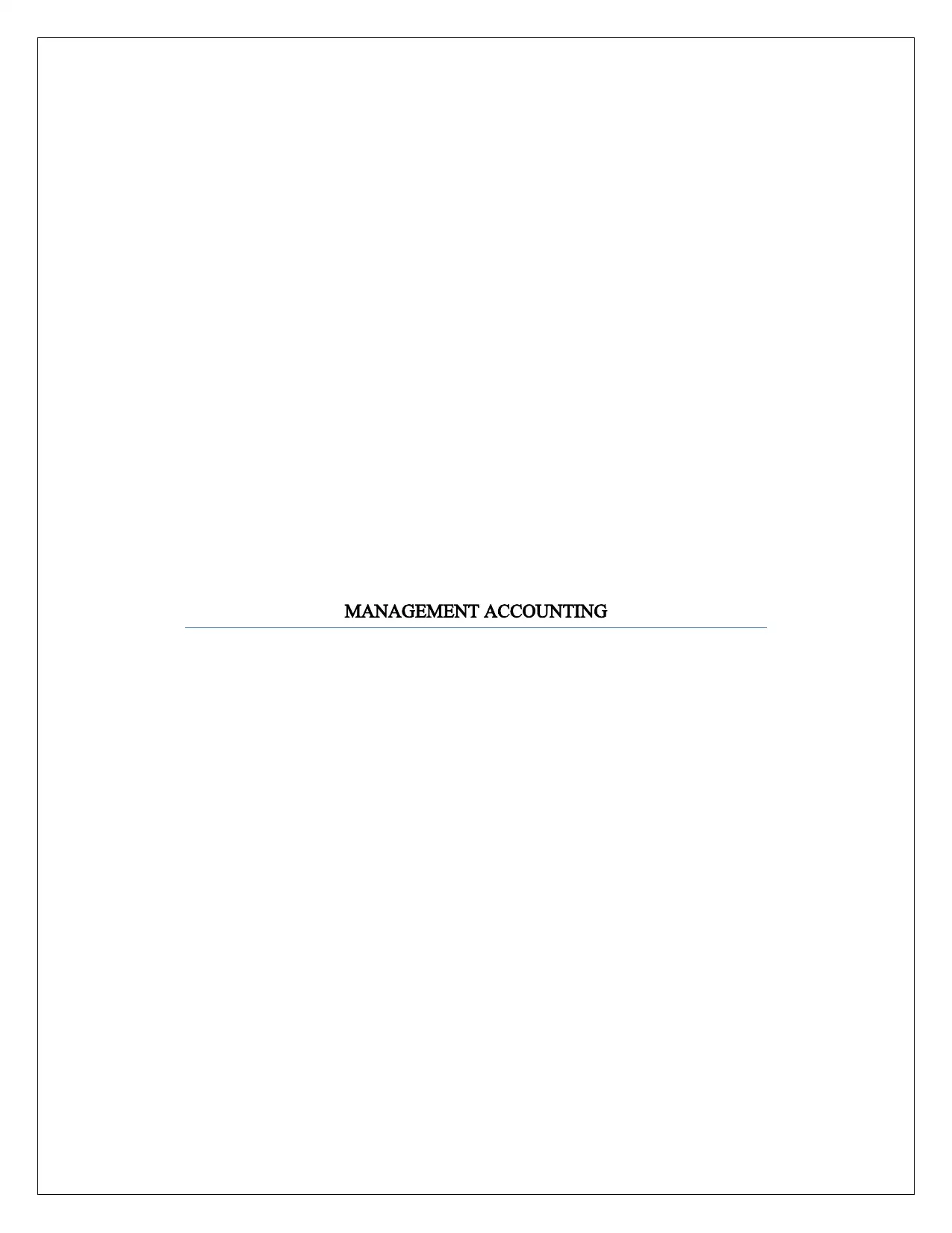
MANAGEMENT ACCOUNTING
Paraphrase This Document
Need a fresh take? Get an instant paraphrase of this document with our AI Paraphraser
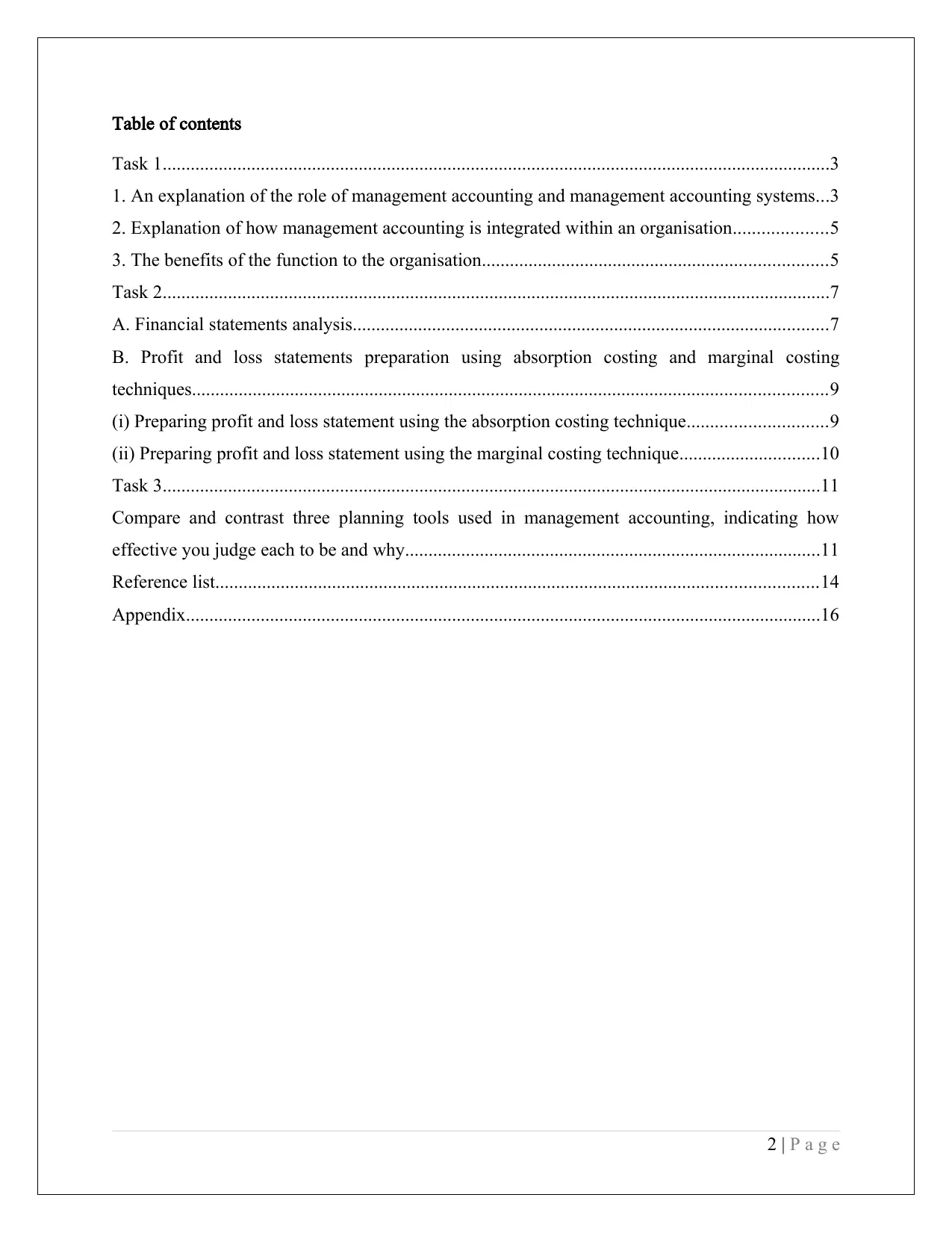
Table of contents
Task 1...............................................................................................................................................3
1. An explanation of the role of management accounting and management accounting systems...3
2. Explanation of how management accounting is integrated within an organisation....................5
3. The benefits of the function to the organisation..........................................................................5
Task 2...............................................................................................................................................7
A. Financial statements analysis......................................................................................................7
B. Profit and loss statements preparation using absorption costing and marginal costing
techniques........................................................................................................................................9
(i) Preparing profit and loss statement using the absorption costing technique..............................9
(ii) Preparing profit and loss statement using the marginal costing technique..............................10
Task 3.............................................................................................................................................11
Compare and contrast three planning tools used in management accounting, indicating how
effective you judge each to be and why.........................................................................................11
Reference list.................................................................................................................................14
Appendix........................................................................................................................................16
2 | P a g e
Task 1...............................................................................................................................................3
1. An explanation of the role of management accounting and management accounting systems...3
2. Explanation of how management accounting is integrated within an organisation....................5
3. The benefits of the function to the organisation..........................................................................5
Task 2...............................................................................................................................................7
A. Financial statements analysis......................................................................................................7
B. Profit and loss statements preparation using absorption costing and marginal costing
techniques........................................................................................................................................9
(i) Preparing profit and loss statement using the absorption costing technique..............................9
(ii) Preparing profit and loss statement using the marginal costing technique..............................10
Task 3.............................................................................................................................................11
Compare and contrast three planning tools used in management accounting, indicating how
effective you judge each to be and why.........................................................................................11
Reference list.................................................................................................................................14
Appendix........................................................................................................................................16
2 | P a g e
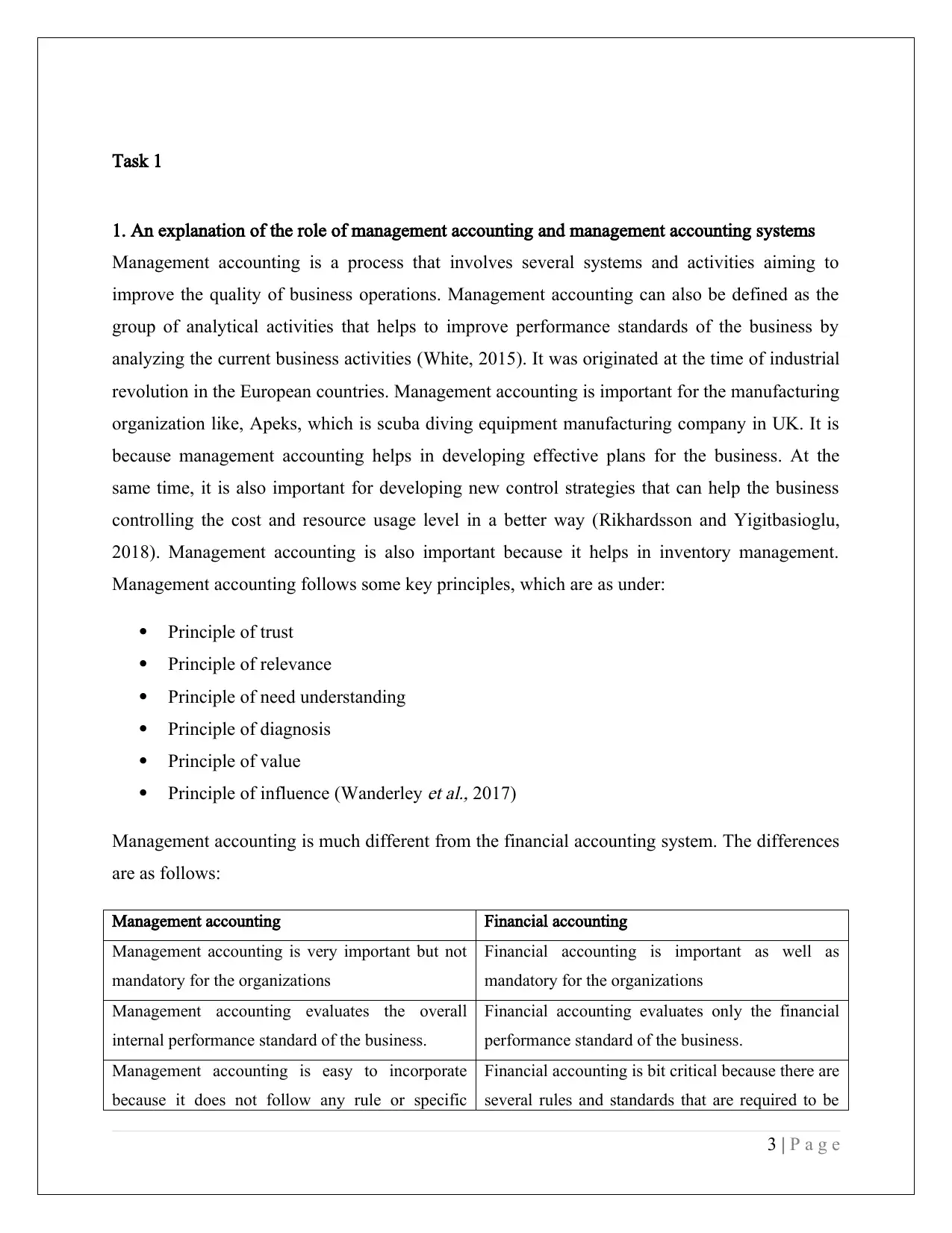
Task 1
1. An explanation of the role of management accounting and management accounting systems
Management accounting is a process that involves several systems and activities aiming to
improve the quality of business operations. Management accounting can also be defined as the
group of analytical activities that helps to improve performance standards of the business by
analyzing the current business activities (White, 2015). It was originated at the time of industrial
revolution in the European countries. Management accounting is important for the manufacturing
organization like, Apeks, which is scuba diving equipment manufacturing company in UK. It is
because management accounting helps in developing effective plans for the business. At the
same time, it is also important for developing new control strategies that can help the business
controlling the cost and resource usage level in a better way (Rikhardsson and Yigitbasioglu,
2018). Management accounting is also important because it helps in inventory management.
Management accounting follows some key principles, which are as under:
Principle of trust
Principle of relevance
Principle of need understanding
Principle of diagnosis
Principle of value
Principle of influence (Wanderley
et al., 2017)
Management accounting is much different from the financial accounting system. The differences
are as follows:
Management accounting Financial accounting
Management accounting is very important but not
mandatory for the organizations
Financial accounting is important as well as
mandatory for the organizations
Management accounting evaluates the overall
internal performance standard of the business.
Financial accounting evaluates only the financial
performance standard of the business.
Management accounting is easy to incorporate
because it does not follow any rule or specific
Financial accounting is bit critical because there are
several rules and standards that are required to be
3 | P a g e
1. An explanation of the role of management accounting and management accounting systems
Management accounting is a process that involves several systems and activities aiming to
improve the quality of business operations. Management accounting can also be defined as the
group of analytical activities that helps to improve performance standards of the business by
analyzing the current business activities (White, 2015). It was originated at the time of industrial
revolution in the European countries. Management accounting is important for the manufacturing
organization like, Apeks, which is scuba diving equipment manufacturing company in UK. It is
because management accounting helps in developing effective plans for the business. At the
same time, it is also important for developing new control strategies that can help the business
controlling the cost and resource usage level in a better way (Rikhardsson and Yigitbasioglu,
2018). Management accounting is also important because it helps in inventory management.
Management accounting follows some key principles, which are as under:
Principle of trust
Principle of relevance
Principle of need understanding
Principle of diagnosis
Principle of value
Principle of influence (Wanderley
et al., 2017)
Management accounting is much different from the financial accounting system. The differences
are as follows:
Management accounting Financial accounting
Management accounting is very important but not
mandatory for the organizations
Financial accounting is important as well as
mandatory for the organizations
Management accounting evaluates the overall
internal performance standard of the business.
Financial accounting evaluates only the financial
performance standard of the business.
Management accounting is easy to incorporate
because it does not follow any rule or specific
Financial accounting is bit critical because there are
several rules and standards that are required to be
3 | P a g e
⊘ This is a preview!⊘
Do you want full access?
Subscribe today to unlock all pages.

Trusted by 1+ million students worldwide
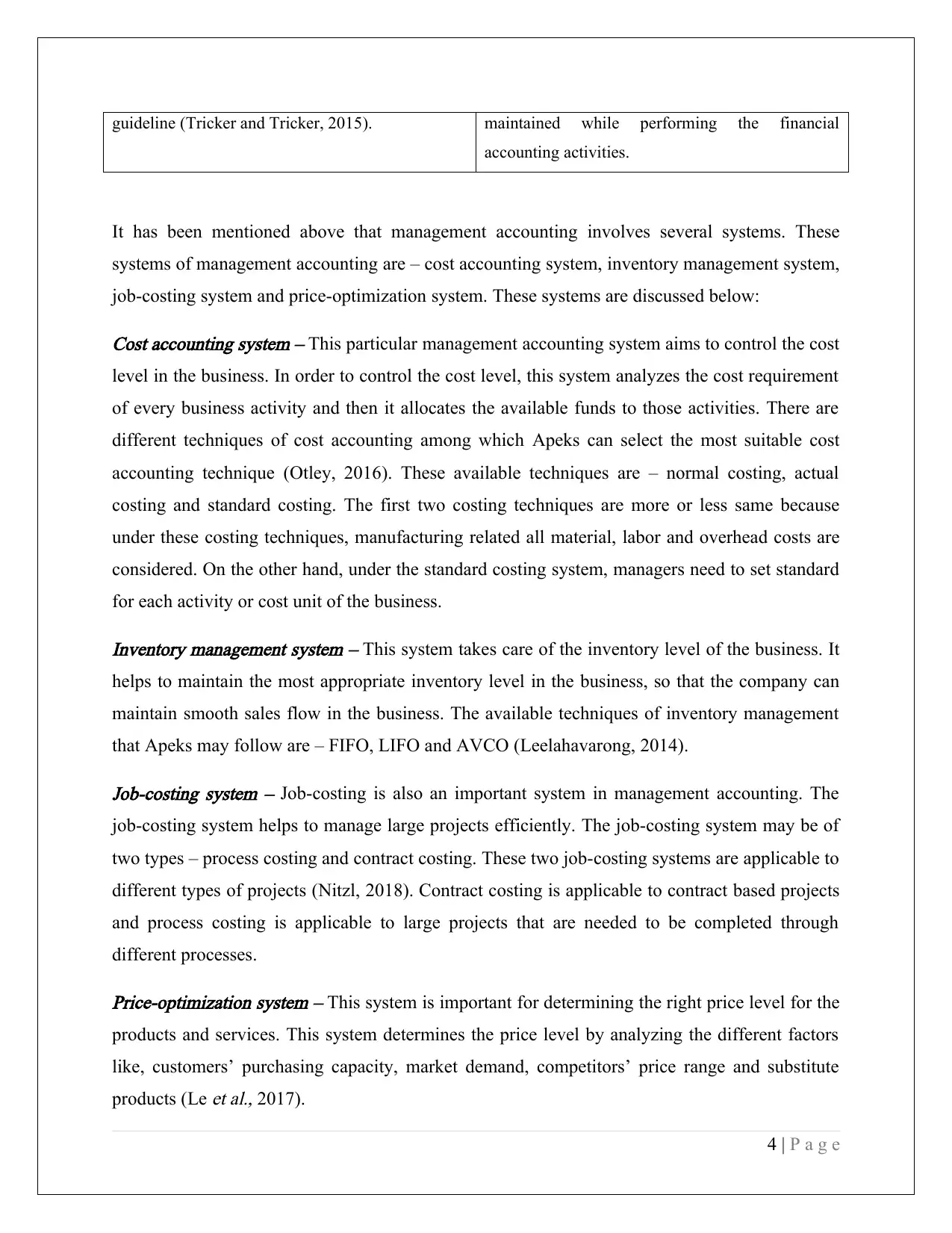
guideline (Tricker and Tricker, 2015). maintained while performing the financial
accounting activities.
It has been mentioned above that management accounting involves several systems. These
systems of management accounting are – cost accounting system, inventory management system,
job-costing system and price-optimization system. These systems are discussed below:
Cost accounting system – This particular management accounting system aims to control the cost
level in the business. In order to control the cost level, this system analyzes the cost requirement
of every business activity and then it allocates the available funds to those activities. There are
different techniques of cost accounting among which Apeks can select the most suitable cost
accounting technique (Otley, 2016). These available techniques are – normal costing, actual
costing and standard costing. The first two costing techniques are more or less same because
under these costing techniques, manufacturing related all material, labor and overhead costs are
considered. On the other hand, under the standard costing system, managers need to set standard
for each activity or cost unit of the business.
Inventory management system – This system takes care of the inventory level of the business. It
helps to maintain the most appropriate inventory level in the business, so that the company can
maintain smooth sales flow in the business. The available techniques of inventory management
that Apeks may follow are – FIFO, LIFO and AVCO (Leelahavarong, 2014).
Job-costing system – Job-costing is also an important system in management accounting. The
job-costing system helps to manage large projects efficiently. The job-costing system may be of
two types – process costing and contract costing. These two job-costing systems are applicable to
different types of projects (Nitzl, 2018). Contract costing is applicable to contract based projects
and process costing is applicable to large projects that are needed to be completed through
different processes.
Price-optimization system – This system is important for determining the right price level for the
products and services. This system determines the price level by analyzing the different factors
like, customers’ purchasing capacity, market demand, competitors’ price range and substitute
products (Le
et al., 2017).
4 | P a g e
accounting activities.
It has been mentioned above that management accounting involves several systems. These
systems of management accounting are – cost accounting system, inventory management system,
job-costing system and price-optimization system. These systems are discussed below:
Cost accounting system – This particular management accounting system aims to control the cost
level in the business. In order to control the cost level, this system analyzes the cost requirement
of every business activity and then it allocates the available funds to those activities. There are
different techniques of cost accounting among which Apeks can select the most suitable cost
accounting technique (Otley, 2016). These available techniques are – normal costing, actual
costing and standard costing. The first two costing techniques are more or less same because
under these costing techniques, manufacturing related all material, labor and overhead costs are
considered. On the other hand, under the standard costing system, managers need to set standard
for each activity or cost unit of the business.
Inventory management system – This system takes care of the inventory level of the business. It
helps to maintain the most appropriate inventory level in the business, so that the company can
maintain smooth sales flow in the business. The available techniques of inventory management
that Apeks may follow are – FIFO, LIFO and AVCO (Leelahavarong, 2014).
Job-costing system – Job-costing is also an important system in management accounting. The
job-costing system helps to manage large projects efficiently. The job-costing system may be of
two types – process costing and contract costing. These two job-costing systems are applicable to
different types of projects (Nitzl, 2018). Contract costing is applicable to contract based projects
and process costing is applicable to large projects that are needed to be completed through
different processes.
Price-optimization system – This system is important for determining the right price level for the
products and services. This system determines the price level by analyzing the different factors
like, customers’ purchasing capacity, market demand, competitors’ price range and substitute
products (Le
et al., 2017).
4 | P a g e
Paraphrase This Document
Need a fresh take? Get an instant paraphrase of this document with our AI Paraphraser
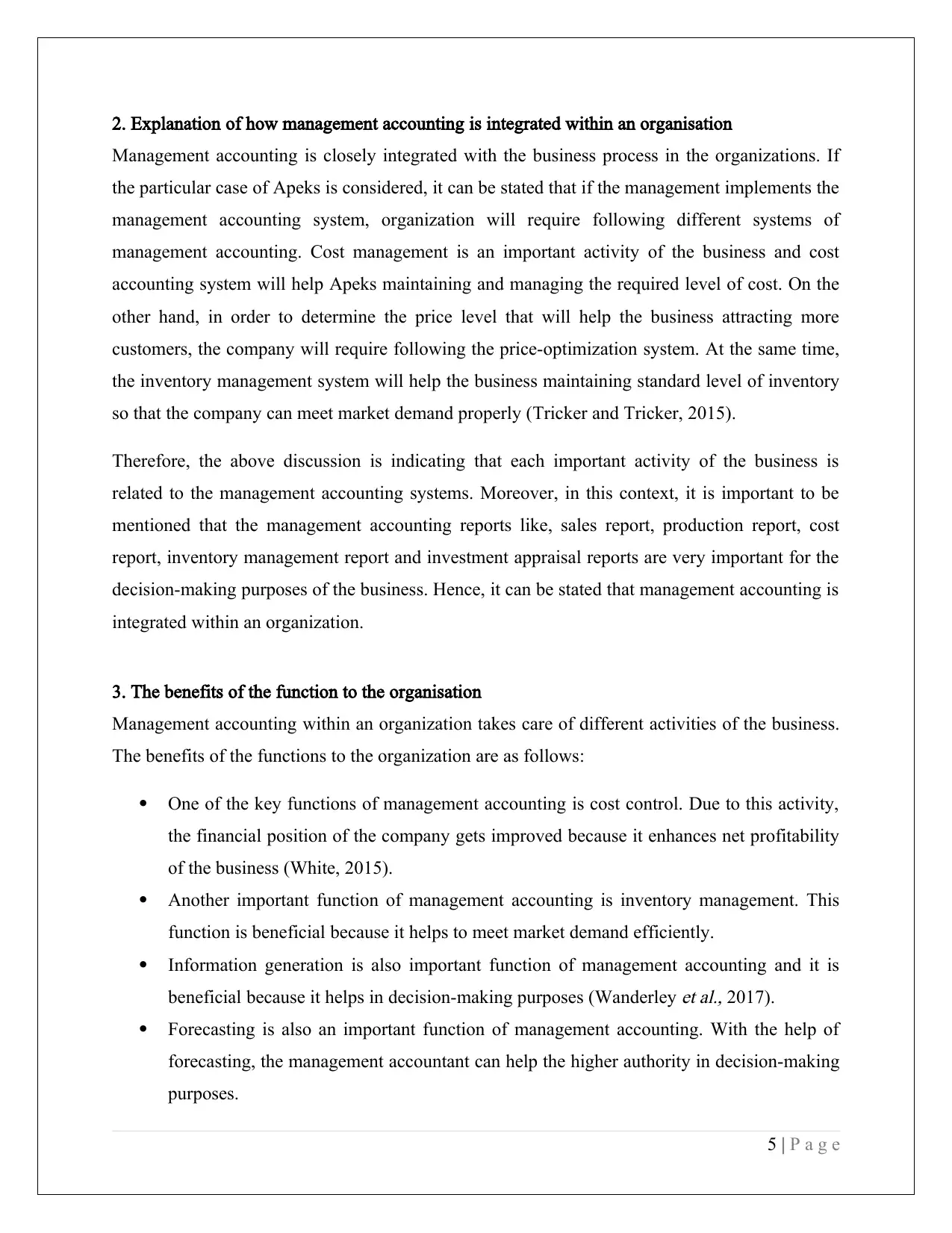
2. Explanation of how management accounting is integrated within an organisation
Management accounting is closely integrated with the business process in the organizations. If
the particular case of Apeks is considered, it can be stated that if the management implements the
management accounting system, organization will require following different systems of
management accounting. Cost management is an important activity of the business and cost
accounting system will help Apeks maintaining and managing the required level of cost. On the
other hand, in order to determine the price level that will help the business attracting more
customers, the company will require following the price-optimization system. At the same time,
the inventory management system will help the business maintaining standard level of inventory
so that the company can meet market demand properly (Tricker and Tricker, 2015).
Therefore, the above discussion is indicating that each important activity of the business is
related to the management accounting systems. Moreover, in this context, it is important to be
mentioned that the management accounting reports like, sales report, production report, cost
report, inventory management report and investment appraisal reports are very important for the
decision-making purposes of the business. Hence, it can be stated that management accounting is
integrated within an organization.
3. The benefits of the function to the organisation
Management accounting within an organization takes care of different activities of the business.
The benefits of the functions to the organization are as follows:
One of the key functions of management accounting is cost control. Due to this activity,
the financial position of the company gets improved because it enhances net profitability
of the business (White, 2015).
Another important function of management accounting is inventory management. This
function is beneficial because it helps to meet market demand efficiently.
Information generation is also important function of management accounting and it is
beneficial because it helps in decision-making purposes (Wanderley
et al., 2017).
Forecasting is also an important function of management accounting. With the help of
forecasting, the management accountant can help the higher authority in decision-making
purposes.
5 | P a g e
Management accounting is closely integrated with the business process in the organizations. If
the particular case of Apeks is considered, it can be stated that if the management implements the
management accounting system, organization will require following different systems of
management accounting. Cost management is an important activity of the business and cost
accounting system will help Apeks maintaining and managing the required level of cost. On the
other hand, in order to determine the price level that will help the business attracting more
customers, the company will require following the price-optimization system. At the same time,
the inventory management system will help the business maintaining standard level of inventory
so that the company can meet market demand properly (Tricker and Tricker, 2015).
Therefore, the above discussion is indicating that each important activity of the business is
related to the management accounting systems. Moreover, in this context, it is important to be
mentioned that the management accounting reports like, sales report, production report, cost
report, inventory management report and investment appraisal reports are very important for the
decision-making purposes of the business. Hence, it can be stated that management accounting is
integrated within an organization.
3. The benefits of the function to the organisation
Management accounting within an organization takes care of different activities of the business.
The benefits of the functions to the organization are as follows:
One of the key functions of management accounting is cost control. Due to this activity,
the financial position of the company gets improved because it enhances net profitability
of the business (White, 2015).
Another important function of management accounting is inventory management. This
function is beneficial because it helps to meet market demand efficiently.
Information generation is also important function of management accounting and it is
beneficial because it helps in decision-making purposes (Wanderley
et al., 2017).
Forecasting is also an important function of management accounting. With the help of
forecasting, the management accountant can help the higher authority in decision-making
purposes.
5 | P a g e
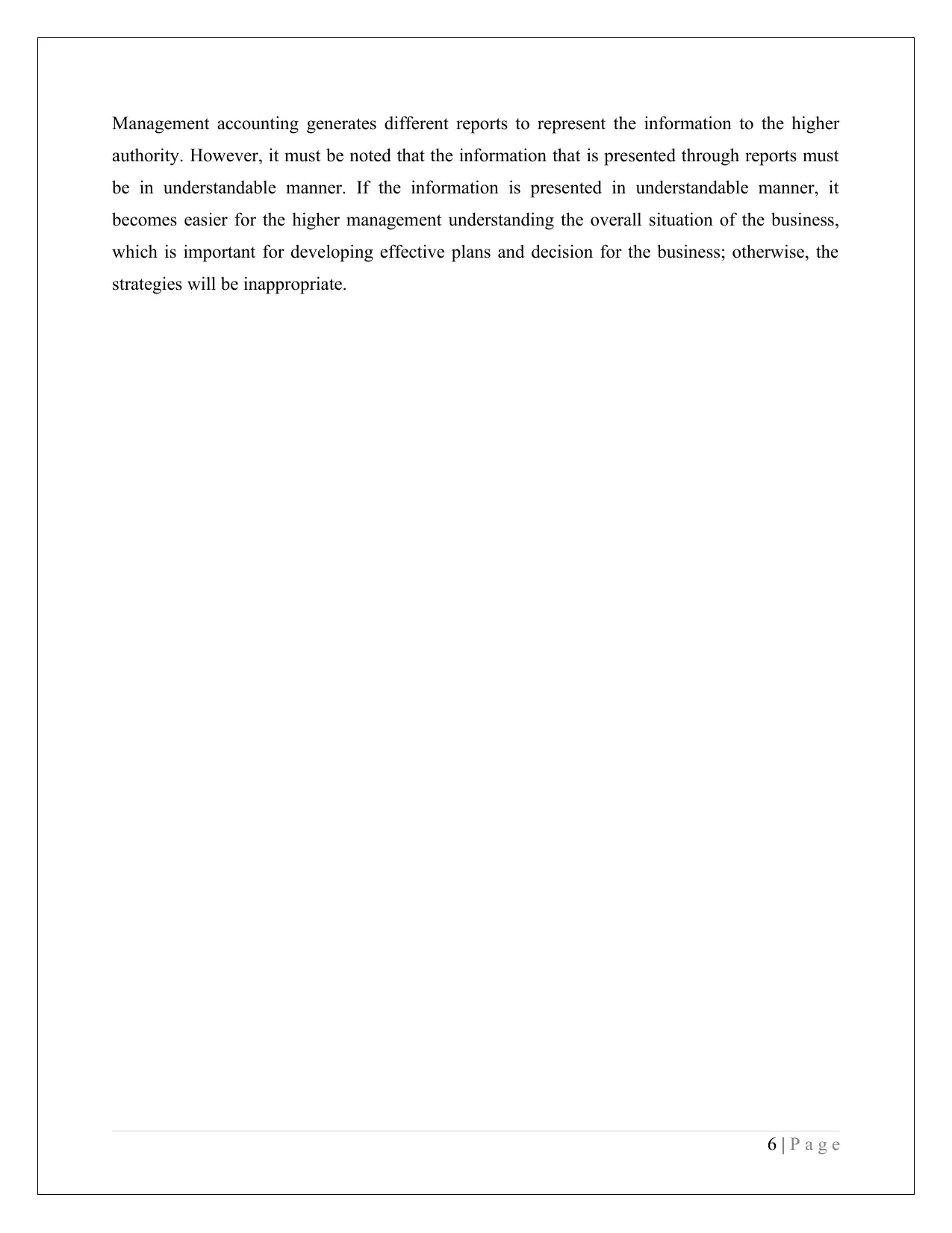
Management accounting generates different reports to represent the information to the higher
authority. However, it must be noted that the information that is presented through reports must
be in understandable manner. If the information is presented in understandable manner, it
becomes easier for the higher management understanding the overall situation of the business,
which is important for developing effective plans and decision for the business; otherwise, the
strategies will be inappropriate.
6 | P a g e
authority. However, it must be noted that the information that is presented through reports must
be in understandable manner. If the information is presented in understandable manner, it
becomes easier for the higher management understanding the overall situation of the business,
which is important for developing effective plans and decision for the business; otherwise, the
strategies will be inappropriate.
6 | P a g e
⊘ This is a preview!⊘
Do you want full access?
Subscribe today to unlock all pages.

Trusted by 1+ million students worldwide
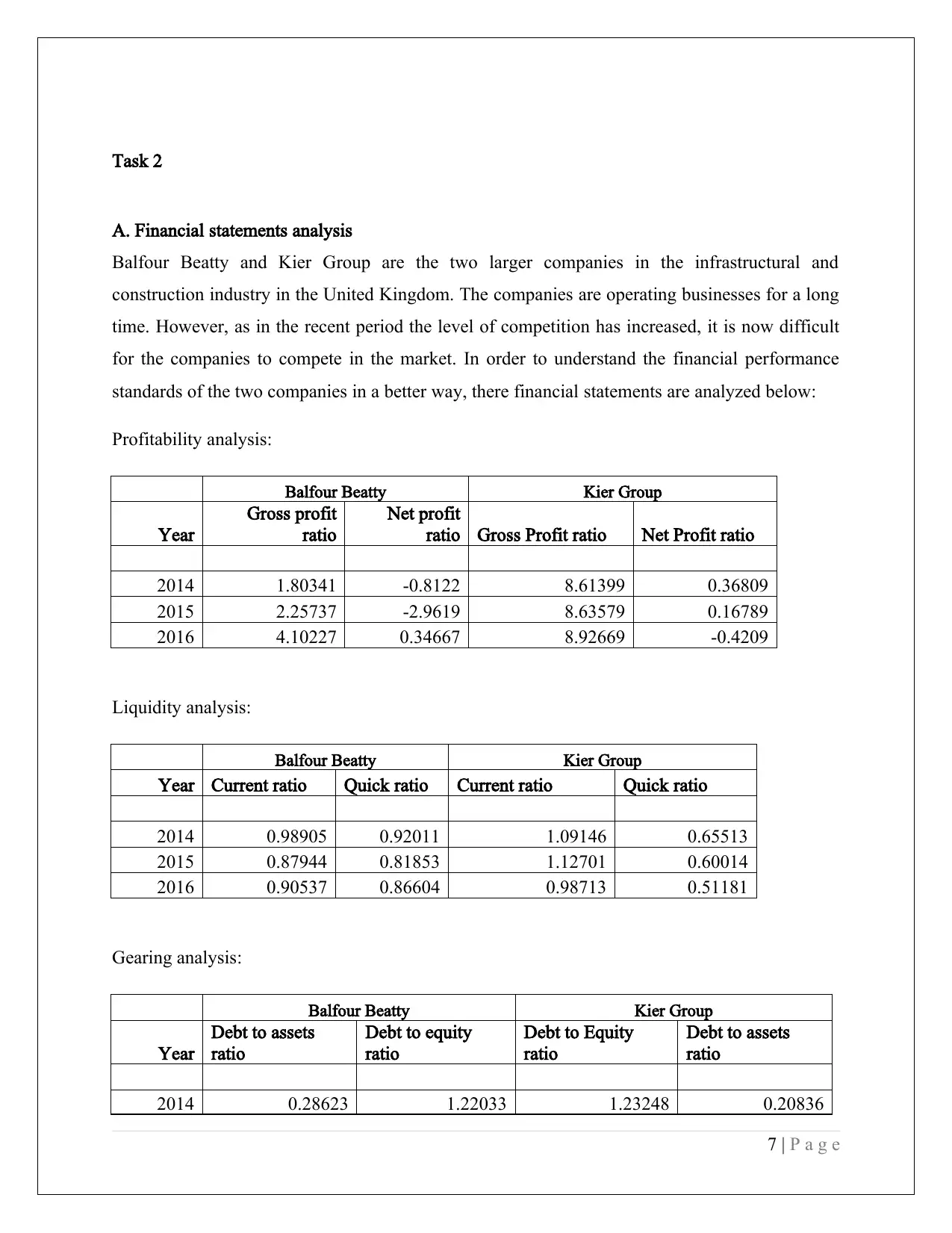
Task 2
A. Financial statements analysis
Balfour Beatty and Kier Group are the two larger companies in the infrastructural and
construction industry in the United Kingdom. The companies are operating businesses for a long
time. However, as in the recent period the level of competition has increased, it is now difficult
for the companies to compete in the market. In order to understand the financial performance
standards of the two companies in a better way, there financial statements are analyzed below:
Profitability analysis:
Balfour Beatty Kier Group
Year
Gross profit
ratio
Net profit
ratio Gross Profit ratio Net Profit ratio
2014 1.80341 -0.8122 8.61399 0.36809
2015 2.25737 -2.9619 8.63579 0.16789
2016 4.10227 0.34667 8.92669 -0.4209
Liquidity analysis:
Balfour Beatty Kier Group
Year Current ratio Quick ratio Current ratio Quick ratio
2014 0.98905 0.92011 1.09146 0.65513
2015 0.87944 0.81853 1.12701 0.60014
2016 0.90537 0.86604 0.98713 0.51181
Gearing analysis:
Balfour Beatty Kier Group
Year
Debt to assets
ratio
Debt to equity
ratio
Debt to Equity
ratio
Debt to assets
ratio
2014 0.28623 1.22033 1.23248 0.20836
7 | P a g e
A. Financial statements analysis
Balfour Beatty and Kier Group are the two larger companies in the infrastructural and
construction industry in the United Kingdom. The companies are operating businesses for a long
time. However, as in the recent period the level of competition has increased, it is now difficult
for the companies to compete in the market. In order to understand the financial performance
standards of the two companies in a better way, there financial statements are analyzed below:
Profitability analysis:
Balfour Beatty Kier Group
Year
Gross profit
ratio
Net profit
ratio Gross Profit ratio Net Profit ratio
2014 1.80341 -0.8122 8.61399 0.36809
2015 2.25737 -2.9619 8.63579 0.16789
2016 4.10227 0.34667 8.92669 -0.4209
Liquidity analysis:
Balfour Beatty Kier Group
Year Current ratio Quick ratio Current ratio Quick ratio
2014 0.98905 0.92011 1.09146 0.65513
2015 0.87944 0.81853 1.12701 0.60014
2016 0.90537 0.86604 0.98713 0.51181
Gearing analysis:
Balfour Beatty Kier Group
Year
Debt to assets
ratio
Debt to equity
ratio
Debt to Equity
ratio
Debt to assets
ratio
2014 0.28623 1.22033 1.23248 0.20836
7 | P a g e
Paraphrase This Document
Need a fresh take? Get an instant paraphrase of this document with our AI Paraphraser
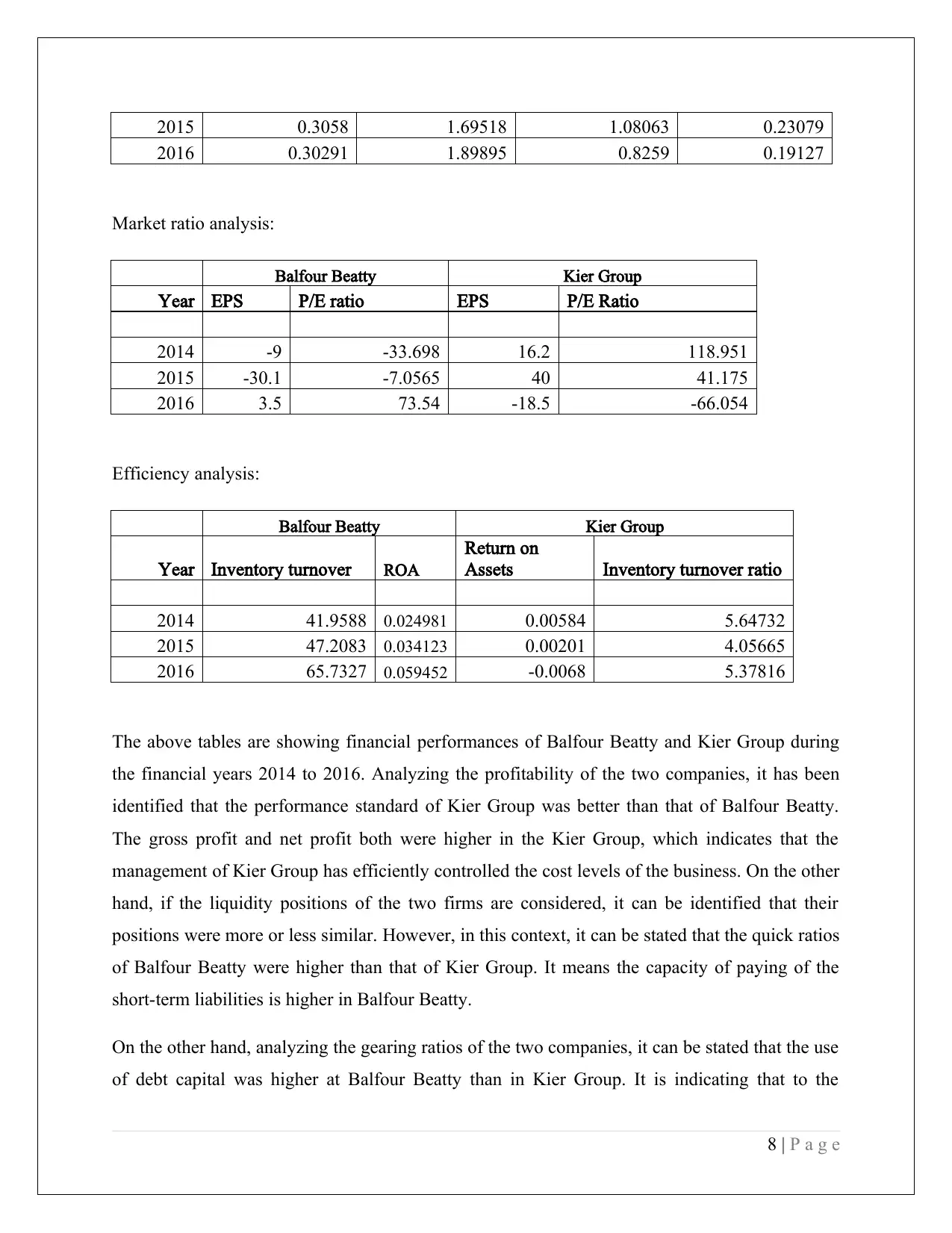
2015 0.3058 1.69518 1.08063 0.23079
2016 0.30291 1.89895 0.8259 0.19127
Market ratio analysis:
Balfour Beatty Kier Group
Year EPS P/E ratio EPS P/E Ratio
2014 -9 -33.698 16.2 118.951
2015 -30.1 -7.0565 40 41.175
2016 3.5 73.54 -18.5 -66.054
Efficiency analysis:
Balfour Beatty Kier Group
Year Inventory turnover ROA
Return on
Assets Inventory turnover ratio
2014 41.9588 0.024981 0.00584 5.64732
2015 47.2083 0.034123 0.00201 4.05665
2016 65.7327 0.059452 -0.0068 5.37816
The above tables are showing financial performances of Balfour Beatty and Kier Group during
the financial years 2014 to 2016. Analyzing the profitability of the two companies, it has been
identified that the performance standard of Kier Group was better than that of Balfour Beatty.
The gross profit and net profit both were higher in the Kier Group, which indicates that the
management of Kier Group has efficiently controlled the cost levels of the business. On the other
hand, if the liquidity positions of the two firms are considered, it can be identified that their
positions were more or less similar. However, in this context, it can be stated that the quick ratios
of Balfour Beatty were higher than that of Kier Group. It means the capacity of paying of the
short-term liabilities is higher in Balfour Beatty.
On the other hand, analyzing the gearing ratios of the two companies, it can be stated that the use
of debt capital was higher at Balfour Beatty than in Kier Group. It is indicating that to the
8 | P a g e
2016 0.30291 1.89895 0.8259 0.19127
Market ratio analysis:
Balfour Beatty Kier Group
Year EPS P/E ratio EPS P/E Ratio
2014 -9 -33.698 16.2 118.951
2015 -30.1 -7.0565 40 41.175
2016 3.5 73.54 -18.5 -66.054
Efficiency analysis:
Balfour Beatty Kier Group
Year Inventory turnover ROA
Return on
Assets Inventory turnover ratio
2014 41.9588 0.024981 0.00584 5.64732
2015 47.2083 0.034123 0.00201 4.05665
2016 65.7327 0.059452 -0.0068 5.37816
The above tables are showing financial performances of Balfour Beatty and Kier Group during
the financial years 2014 to 2016. Analyzing the profitability of the two companies, it has been
identified that the performance standard of Kier Group was better than that of Balfour Beatty.
The gross profit and net profit both were higher in the Kier Group, which indicates that the
management of Kier Group has efficiently controlled the cost levels of the business. On the other
hand, if the liquidity positions of the two firms are considered, it can be identified that their
positions were more or less similar. However, in this context, it can be stated that the quick ratios
of Balfour Beatty were higher than that of Kier Group. It means the capacity of paying of the
short-term liabilities is higher in Balfour Beatty.
On the other hand, analyzing the gearing ratios of the two companies, it can be stated that the use
of debt capital was higher at Balfour Beatty than in Kier Group. It is indicating that to the
8 | P a g e
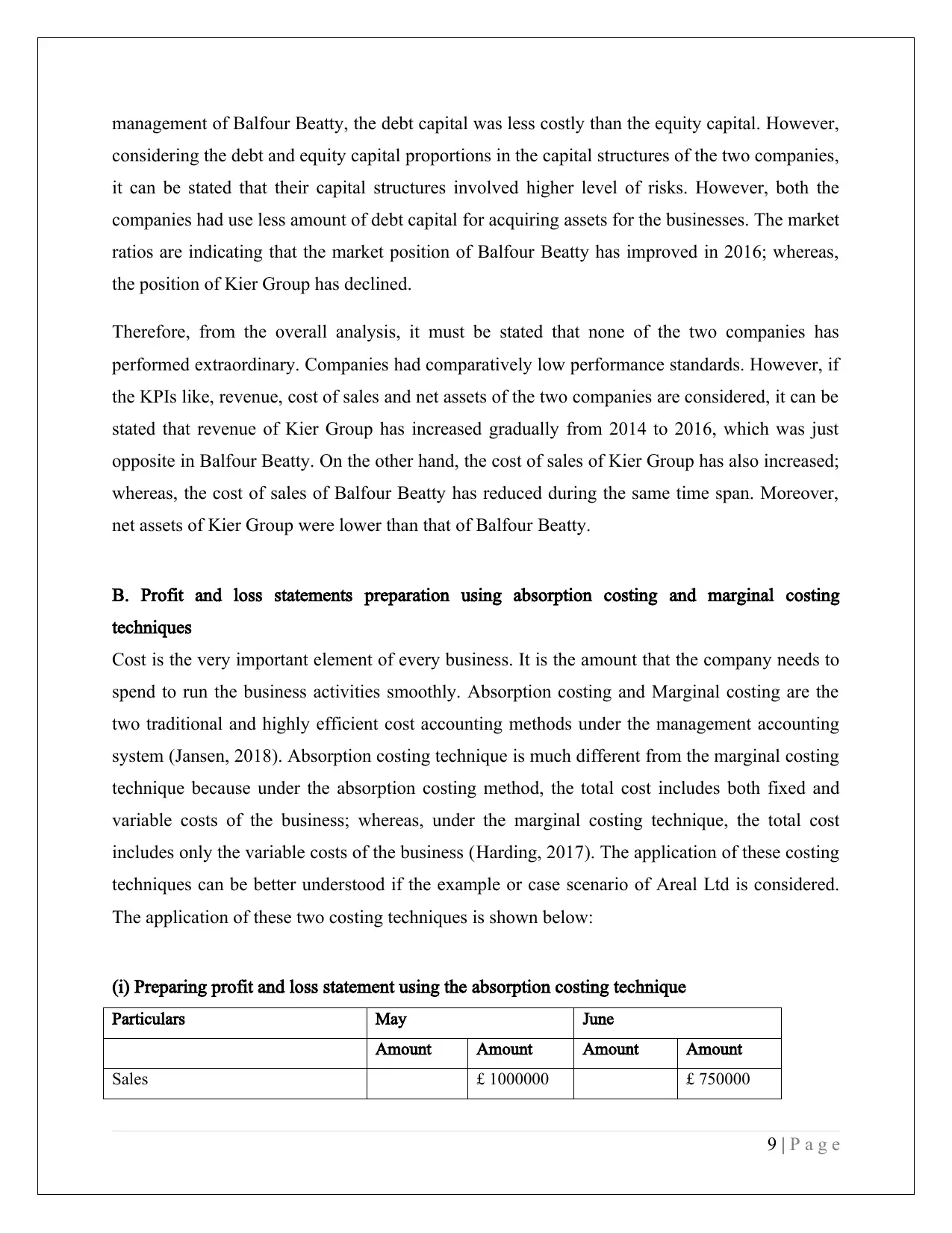
management of Balfour Beatty, the debt capital was less costly than the equity capital. However,
considering the debt and equity capital proportions in the capital structures of the two companies,
it can be stated that their capital structures involved higher level of risks. However, both the
companies had use less amount of debt capital for acquiring assets for the businesses. The market
ratios are indicating that the market position of Balfour Beatty has improved in 2016; whereas,
the position of Kier Group has declined.
Therefore, from the overall analysis, it must be stated that none of the two companies has
performed extraordinary. Companies had comparatively low performance standards. However, if
the KPIs like, revenue, cost of sales and net assets of the two companies are considered, it can be
stated that revenue of Kier Group has increased gradually from 2014 to 2016, which was just
opposite in Balfour Beatty. On the other hand, the cost of sales of Kier Group has also increased;
whereas, the cost of sales of Balfour Beatty has reduced during the same time span. Moreover,
net assets of Kier Group were lower than that of Balfour Beatty.
B. Profit and loss statements preparation using absorption costing and marginal costing
techniques
Cost is the very important element of every business. It is the amount that the company needs to
spend to run the business activities smoothly. Absorption costing and Marginal costing are the
two traditional and highly efficient cost accounting methods under the management accounting
system (Jansen, 2018). Absorption costing technique is much different from the marginal costing
technique because under the absorption costing method, the total cost includes both fixed and
variable costs of the business; whereas, under the marginal costing technique, the total cost
includes only the variable costs of the business (Harding, 2017). The application of these costing
techniques can be better understood if the example or case scenario of Areal Ltd is considered.
The application of these two costing techniques is shown below:
(i) Preparing profit and loss statement using the absorption costing technique
Particulars May June
Amount Amount Amount Amount
Sales £ 1000000 £ 750000
9 | P a g e
considering the debt and equity capital proportions in the capital structures of the two companies,
it can be stated that their capital structures involved higher level of risks. However, both the
companies had use less amount of debt capital for acquiring assets for the businesses. The market
ratios are indicating that the market position of Balfour Beatty has improved in 2016; whereas,
the position of Kier Group has declined.
Therefore, from the overall analysis, it must be stated that none of the two companies has
performed extraordinary. Companies had comparatively low performance standards. However, if
the KPIs like, revenue, cost of sales and net assets of the two companies are considered, it can be
stated that revenue of Kier Group has increased gradually from 2014 to 2016, which was just
opposite in Balfour Beatty. On the other hand, the cost of sales of Kier Group has also increased;
whereas, the cost of sales of Balfour Beatty has reduced during the same time span. Moreover,
net assets of Kier Group were lower than that of Balfour Beatty.
B. Profit and loss statements preparation using absorption costing and marginal costing
techniques
Cost is the very important element of every business. It is the amount that the company needs to
spend to run the business activities smoothly. Absorption costing and Marginal costing are the
two traditional and highly efficient cost accounting methods under the management accounting
system (Jansen, 2018). Absorption costing technique is much different from the marginal costing
technique because under the absorption costing method, the total cost includes both fixed and
variable costs of the business; whereas, under the marginal costing technique, the total cost
includes only the variable costs of the business (Harding, 2017). The application of these costing
techniques can be better understood if the example or case scenario of Areal Ltd is considered.
The application of these two costing techniques is shown below:
(i) Preparing profit and loss statement using the absorption costing technique
Particulars May June
Amount Amount Amount Amount
Sales £ 1000000 £ 750000
9 | P a g e
⊘ This is a preview!⊘
Do you want full access?
Subscribe today to unlock all pages.

Trusted by 1+ million students worldwide
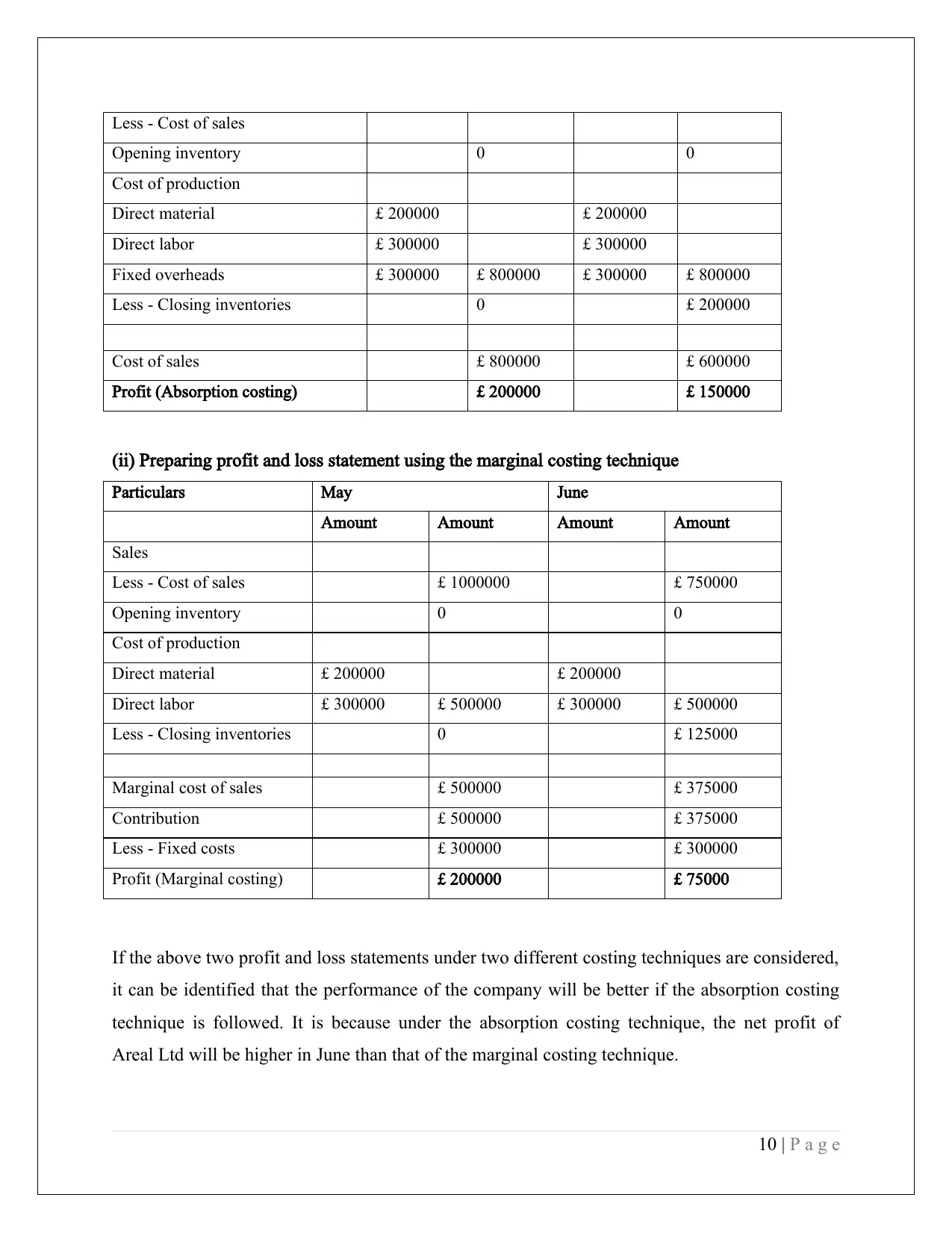
Less - Cost of sales
Opening inventory 0 0
Cost of production
Direct material £ 200000 £ 200000
Direct labor £ 300000 £ 300000
Fixed overheads £ 300000 £ 800000 £ 300000 £ 800000
Less - Closing inventories 0 £ 200000
Cost of sales £ 800000 £ 600000
Profit (Absorption costing) £ 200000 £ 150000
(ii) Preparing profit and loss statement using the marginal costing technique
Particulars May June
Amount Amount Amount Amount
Sales
Less - Cost of sales £ 1000000 £ 750000
Opening inventory 0 0
Cost of production
Direct material £ 200000 £ 200000
Direct labor £ 300000 £ 500000 £ 300000 £ 500000
Less - Closing inventories 0 £ 125000
Marginal cost of sales £ 500000 £ 375000
Contribution £ 500000 £ 375000
Less - Fixed costs £ 300000 £ 300000
Profit (Marginal costing) £ 200000 £ 75000
If the above two profit and loss statements under two different costing techniques are considered,
it can be identified that the performance of the company will be better if the absorption costing
technique is followed. It is because under the absorption costing technique, the net profit of
Areal Ltd will be higher in June than that of the marginal costing technique.
10 | P a g e
Opening inventory 0 0
Cost of production
Direct material £ 200000 £ 200000
Direct labor £ 300000 £ 300000
Fixed overheads £ 300000 £ 800000 £ 300000 £ 800000
Less - Closing inventories 0 £ 200000
Cost of sales £ 800000 £ 600000
Profit (Absorption costing) £ 200000 £ 150000
(ii) Preparing profit and loss statement using the marginal costing technique
Particulars May June
Amount Amount Amount Amount
Sales
Less - Cost of sales £ 1000000 £ 750000
Opening inventory 0 0
Cost of production
Direct material £ 200000 £ 200000
Direct labor £ 300000 £ 500000 £ 300000 £ 500000
Less - Closing inventories 0 £ 125000
Marginal cost of sales £ 500000 £ 375000
Contribution £ 500000 £ 375000
Less - Fixed costs £ 300000 £ 300000
Profit (Marginal costing) £ 200000 £ 75000
If the above two profit and loss statements under two different costing techniques are considered,
it can be identified that the performance of the company will be better if the absorption costing
technique is followed. It is because under the absorption costing technique, the net profit of
Areal Ltd will be higher in June than that of the marginal costing technique.
10 | P a g e
Paraphrase This Document
Need a fresh take? Get an instant paraphrase of this document with our AI Paraphraser
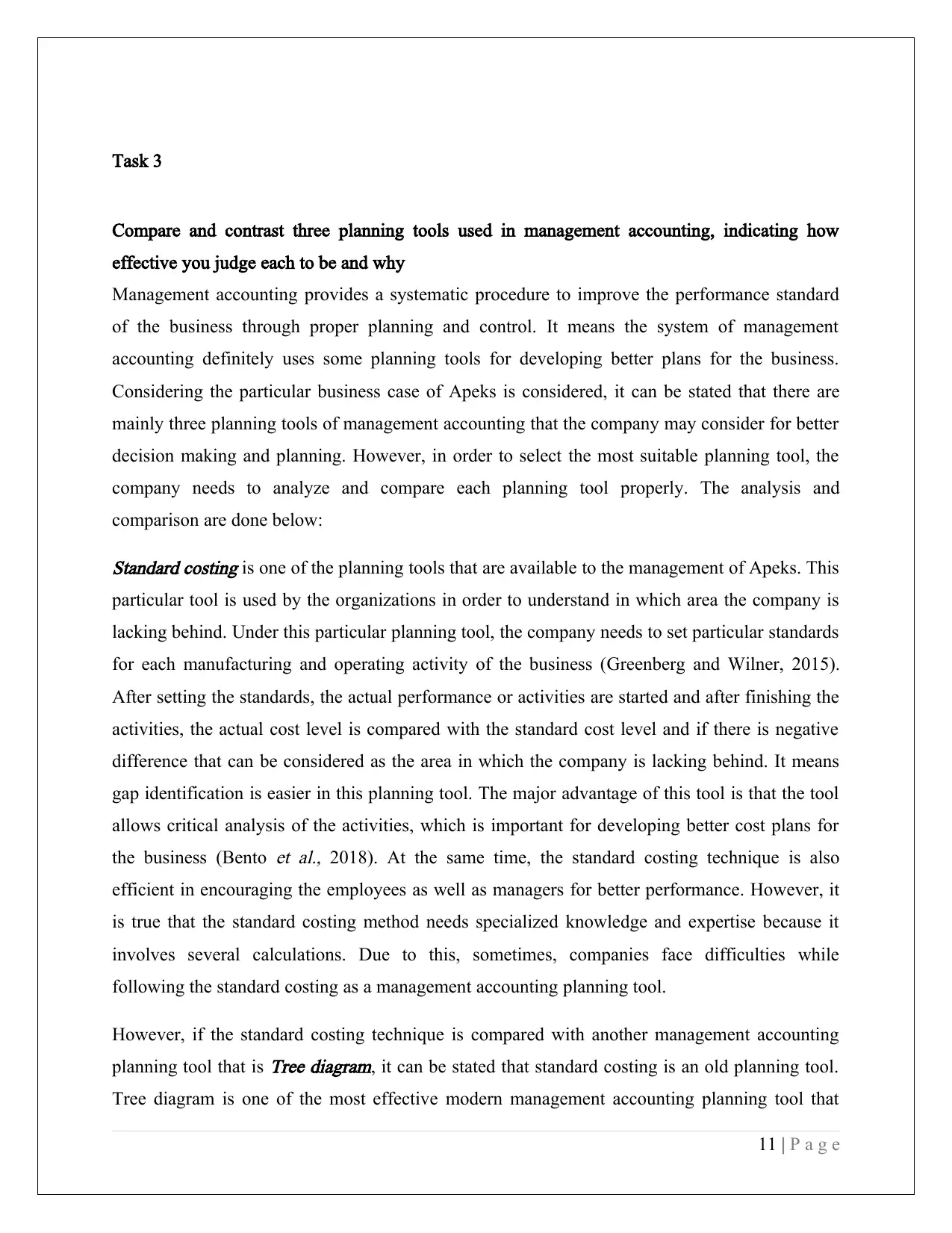
Task 3
Compare and contrast three planning tools used in management accounting, indicating how
effective you judge each to be and why
Management accounting provides a systematic procedure to improve the performance standard
of the business through proper planning and control. It means the system of management
accounting definitely uses some planning tools for developing better plans for the business.
Considering the particular business case of Apeks is considered, it can be stated that there are
mainly three planning tools of management accounting that the company may consider for better
decision making and planning. However, in order to select the most suitable planning tool, the
company needs to analyze and compare each planning tool properly. The analysis and
comparison are done below:
Standard costing is one of the planning tools that are available to the management of Apeks. This
particular tool is used by the organizations in order to understand in which area the company is
lacking behind. Under this particular planning tool, the company needs to set particular standards
for each manufacturing and operating activity of the business (Greenberg and Wilner, 2015).
After setting the standards, the actual performance or activities are started and after finishing the
activities, the actual cost level is compared with the standard cost level and if there is negative
difference that can be considered as the area in which the company is lacking behind. It means
gap identification is easier in this planning tool. The major advantage of this tool is that the tool
allows critical analysis of the activities, which is important for developing better cost plans for
the business (Bento
et al., 2018). At the same time, the standard costing technique is also
efficient in encouraging the employees as well as managers for better performance. However, it
is true that the standard costing method needs specialized knowledge and expertise because it
involves several calculations. Due to this, sometimes, companies face difficulties while
following the standard costing as a management accounting planning tool.
However, if the standard costing technique is compared with another management accounting
planning tool that is
Tree diagram, it can be stated that standard costing is an old planning tool.
Tree diagram is one of the most effective modern management accounting planning tool that
11 | P a g e
Compare and contrast three planning tools used in management accounting, indicating how
effective you judge each to be and why
Management accounting provides a systematic procedure to improve the performance standard
of the business through proper planning and control. It means the system of management
accounting definitely uses some planning tools for developing better plans for the business.
Considering the particular business case of Apeks is considered, it can be stated that there are
mainly three planning tools of management accounting that the company may consider for better
decision making and planning. However, in order to select the most suitable planning tool, the
company needs to analyze and compare each planning tool properly. The analysis and
comparison are done below:
Standard costing is one of the planning tools that are available to the management of Apeks. This
particular tool is used by the organizations in order to understand in which area the company is
lacking behind. Under this particular planning tool, the company needs to set particular standards
for each manufacturing and operating activity of the business (Greenberg and Wilner, 2015).
After setting the standards, the actual performance or activities are started and after finishing the
activities, the actual cost level is compared with the standard cost level and if there is negative
difference that can be considered as the area in which the company is lacking behind. It means
gap identification is easier in this planning tool. The major advantage of this tool is that the tool
allows critical analysis of the activities, which is important for developing better cost plans for
the business (Bento
et al., 2018). At the same time, the standard costing technique is also
efficient in encouraging the employees as well as managers for better performance. However, it
is true that the standard costing method needs specialized knowledge and expertise because it
involves several calculations. Due to this, sometimes, companies face difficulties while
following the standard costing as a management accounting planning tool.
However, if the standard costing technique is compared with another management accounting
planning tool that is
Tree diagram, it can be stated that standard costing is an old planning tool.
Tree diagram is one of the most effective modern management accounting planning tool that
11 | P a g e
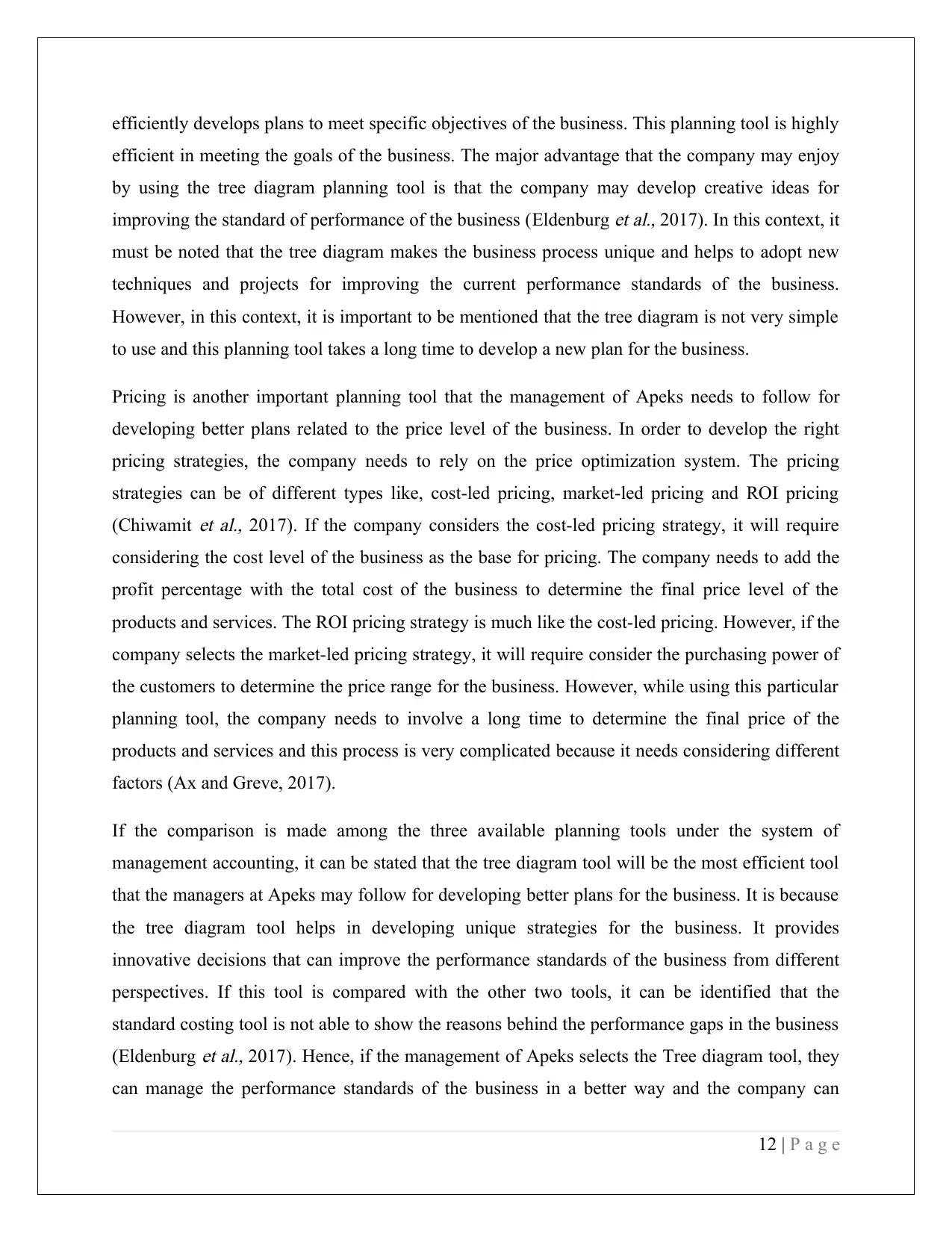
efficiently develops plans to meet specific objectives of the business. This planning tool is highly
efficient in meeting the goals of the business. The major advantage that the company may enjoy
by using the tree diagram planning tool is that the company may develop creative ideas for
improving the standard of performance of the business (Eldenburg
et al., 2017). In this context, it
must be noted that the tree diagram makes the business process unique and helps to adopt new
techniques and projects for improving the current performance standards of the business.
However, in this context, it is important to be mentioned that the tree diagram is not very simple
to use and this planning tool takes a long time to develop a new plan for the business.
Pricing is another important planning tool that the management of Apeks needs to follow for
developing better plans related to the price level of the business. In order to develop the right
pricing strategies, the company needs to rely on the price optimization system. The pricing
strategies can be of different types like, cost-led pricing, market-led pricing and ROI pricing
(Chiwamit
et al., 2017). If the company considers the cost-led pricing strategy, it will require
considering the cost level of the business as the base for pricing. The company needs to add the
profit percentage with the total cost of the business to determine the final price level of the
products and services. The ROI pricing strategy is much like the cost-led pricing. However, if the
company selects the market-led pricing strategy, it will require consider the purchasing power of
the customers to determine the price range for the business. However, while using this particular
planning tool, the company needs to involve a long time to determine the final price of the
products and services and this process is very complicated because it needs considering different
factors (Ax and Greve, 2017).
If the comparison is made among the three available planning tools under the system of
management accounting, it can be stated that the tree diagram tool will be the most efficient tool
that the managers at Apeks may follow for developing better plans for the business. It is because
the tree diagram tool helps in developing unique strategies for the business. It provides
innovative decisions that can improve the performance standards of the business from different
perspectives. If this tool is compared with the other two tools, it can be identified that the
standard costing tool is not able to show the reasons behind the performance gaps in the business
(Eldenburg
et al., 2017). Hence, if the management of Apeks selects the Tree diagram tool, they
can manage the performance standards of the business in a better way and the company can
12 | P a g e
efficient in meeting the goals of the business. The major advantage that the company may enjoy
by using the tree diagram planning tool is that the company may develop creative ideas for
improving the standard of performance of the business (Eldenburg
et al., 2017). In this context, it
must be noted that the tree diagram makes the business process unique and helps to adopt new
techniques and projects for improving the current performance standards of the business.
However, in this context, it is important to be mentioned that the tree diagram is not very simple
to use and this planning tool takes a long time to develop a new plan for the business.
Pricing is another important planning tool that the management of Apeks needs to follow for
developing better plans related to the price level of the business. In order to develop the right
pricing strategies, the company needs to rely on the price optimization system. The pricing
strategies can be of different types like, cost-led pricing, market-led pricing and ROI pricing
(Chiwamit
et al., 2017). If the company considers the cost-led pricing strategy, it will require
considering the cost level of the business as the base for pricing. The company needs to add the
profit percentage with the total cost of the business to determine the final price level of the
products and services. The ROI pricing strategy is much like the cost-led pricing. However, if the
company selects the market-led pricing strategy, it will require consider the purchasing power of
the customers to determine the price range for the business. However, while using this particular
planning tool, the company needs to involve a long time to determine the final price of the
products and services and this process is very complicated because it needs considering different
factors (Ax and Greve, 2017).
If the comparison is made among the three available planning tools under the system of
management accounting, it can be stated that the tree diagram tool will be the most efficient tool
that the managers at Apeks may follow for developing better plans for the business. It is because
the tree diagram tool helps in developing unique strategies for the business. It provides
innovative decisions that can improve the performance standards of the business from different
perspectives. If this tool is compared with the other two tools, it can be identified that the
standard costing tool is not able to show the reasons behind the performance gaps in the business
(Eldenburg
et al., 2017). Hence, if the management of Apeks selects the Tree diagram tool, they
can manage the performance standards of the business in a better way and the company can
12 | P a g e
⊘ This is a preview!⊘
Do you want full access?
Subscribe today to unlock all pages.

Trusted by 1+ million students worldwide
1 out of 20
Related Documents
Your All-in-One AI-Powered Toolkit for Academic Success.
+13062052269
info@desklib.com
Available 24*7 on WhatsApp / Email
![[object Object]](/_next/static/media/star-bottom.7253800d.svg)
Unlock your academic potential
Copyright © 2020–2025 A2Z Services. All Rights Reserved. Developed and managed by ZUCOL.





